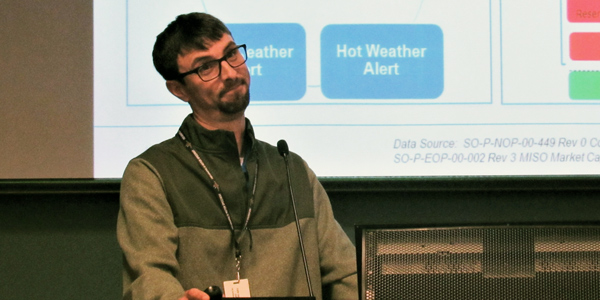By Amanda Durish Cook
CARMEL, Ind. — While MISO says it’s ready for a warmer-than-normal summer, RTO officials cautioned Tuesday that operators will likely lean on demand response resources to manage loads at some point during the season.
During an April 24 summer readiness workshop, MISO officials stressed that summer capacity levels will exceed the forecasted 2018 summer peak demand and reserve margin requirement.
However, the RTO foresees a 79% probability it will call up load-modifying resources, a 17% probability of using operating reserves and a 9% chance it will be forced to shed load.
MISO predicts a 124.7-GW summer coincident peak with 148.6 GW in available supply and 11.4 GW in anticipated reserves after accounting for typical outages. Last summer, MISO predicted 148.5 GW worth of supply to meet a 125-GW peak demand, 4 GW shy of MISO’s 121-GW actual peak load set in July.
“We have adequate supply to meet our expectations for this summer,” MISO Senior Director of Systemwide Operations Rob Benbow told stakeholders.
Likewise, Kojo Sefah, a MISO resource adequacy engineer, said the RTO’s transmission assessment showed no major constraints this summer.
However, MISO is predicting negative load growth combined with an increased use of behind-the-meter generation and demand response to meet the reserve margin.
“Negative load growth combined with an increase in behind-the-meter generation and demand response have increased our base reserve margin. What’s that mean? We’re going to use more [load-modifying resources] if we have to,” said MISO shift operator Trevor Hines. “ … That’s what they’re for.”
In a high-load, high-outage scenario, MISO expects to “rely heavily” on demand response, said Eric Rodriguez, of MISO’s resource adequacy division.
Hines said in a high-load, high-outage scenario, MISO is “3.3 GW of demand response away from having to use operating reserves to serve load.”
Beginning in June, MISO will have a 17.1% planning reserve margin, based on limiting the likelihood of shedding load to no more than one day in 10 years. Last year’s margin was 15.8%. The RTO said the shrinking load growth and increasing DR and BTM generation use helped boost the planning reserve margin.
MISO said while negative demand growth has helped increase reserves, the percentage of reserves available beyond the minimum requirement has decreased. During the 2016/17 and 2017/18 planning years, MISO had an additional 3% of reserves on hand. This summer, the RTO predicts 2% in additional reserves.
MISO said its summer predictions were predicated on the megawatts available in this month’s Planning Resource Auction. Additional non-firm generation support may be available but cannot be definitively counted, the RTO said. (See MISO Clears at $10/MW-day in 2018/19 Capacity Auction.)
Rodriguez said the number of planned, maintenance and forced outages this summer are expected to be consistent with outage levels over the past five years. Last year, MISO experienced roughly 15-17.5 GW in outages during summer peak times.
Customized Energy Solutions’ David Sapper said he didn’t understand why MISO was putting such a “spotlight” on mitigating outages in other stakeholder discussions when it did not expect outages to increase this summer. MISO officials have said outages have played a role in most of the RTO’s maximum generation events since late 2016, and they are looking into forecasting the effects of planned and maintenance outages on peak in its loss-of-load expectation study by the 2019/20 planning year. (See MISO Looks to Address Changing Resource Availability.)
MISO officials nevertheless said they stood by their summer outage prediction for this year.
Summer 2018 Weather
Using forecasts from the National Oceanic and Atmospheric Administration, MISO is expecting a warmer-than-normal summer for the footprint ― especially in MISO South, with normal precipitation levels in MISO Midwest but lower-than-normal precipitation in the South region.
“Sustained high temperatures can have an impact” on day-to-day operations, Rodriguez said.
Hurricane Prep
MISO is preparing for at least one major storm to hit the Gulf Coast portions of MISO South.
Colorado State University’s Tropical Meteorology Project predicts 14 hurricanes for this summer, with seven of those developing into Category 3 or higher storms.
MISO South operations adviser Gerald Rusin said MISO will continue to use its hurricane action plan, which includes conducting a 31-hour, Category 4 storm simulation depicting multiple islanding events within the electric system.
Rusin said the university group sees a 38% chance of “at least one major hurricane making landfall along the Gulf Coast from the Florida Panhandle to Brownsville, Texas.”
“There were four tropical weather events that took aim at MISO South last year,” Rusin pointed out.
Rusin said last year MISO maintained reliability through Hurricane Harvey’s “unimaginable flooding” in the Lake Charles, La. area. Harvey submerged some substations and caused months-long generation outages in the Entergy footprint, he said.
MISO will hold a second hurricane preparedness drill with six MISO South market members May 16-17. A previous drill took place in mid-April.







